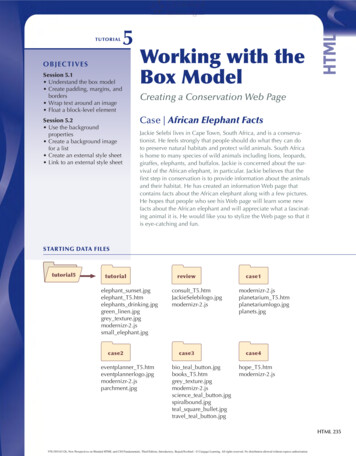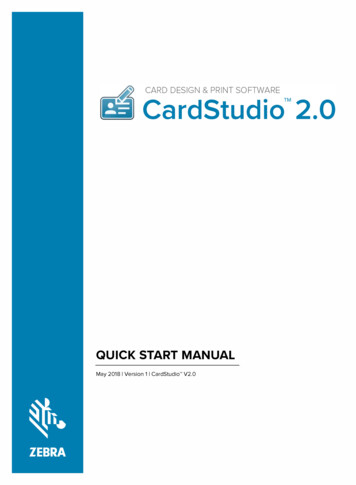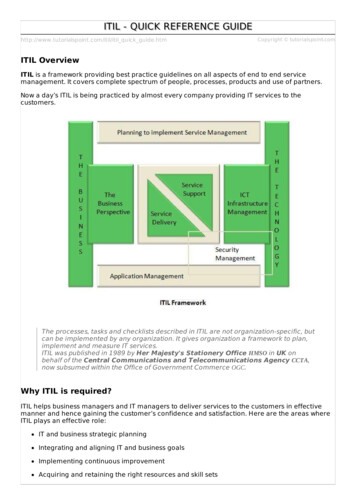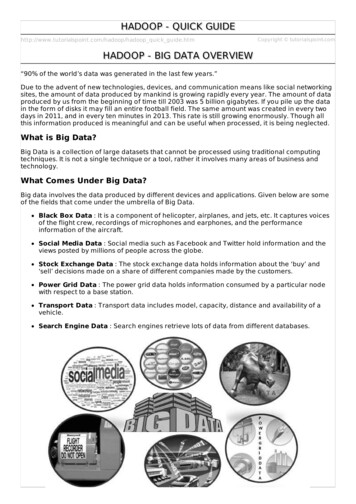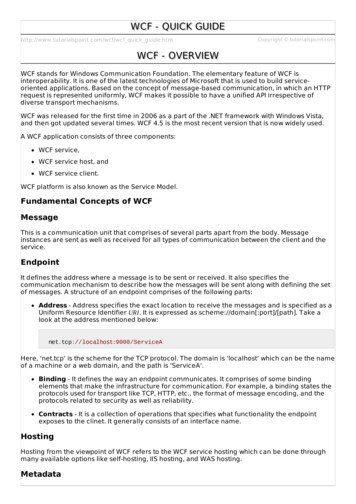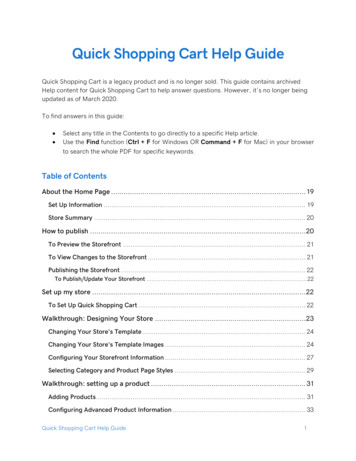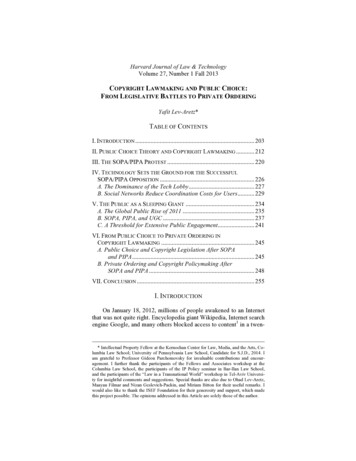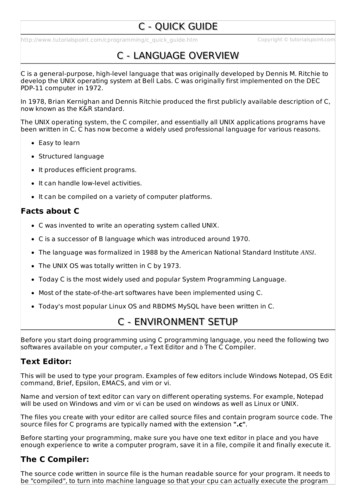
Transcription
C - QUICK GUIDEhttp://www.tutorialspoint.com/cprogramming/c quick guide.htmCopyright tutorialspoint.comC - LANGUAGE OVERVIEWC is a general-purpose, high-level language that was originally developed by Dennis M. Ritchie todevelop the UNIX operating system at Bell Labs. C was originally first implemented on the DECPDP-11 computer in 1972.In 1978, Brian Kernighan and Dennis Ritchie produced the first publicly available description of C,now known as the K&R standard.The UNIX operating system, the C compiler, and essentially all UNIX applications programs havebeen written in C. C has now become a widely used professional language for various reasons.Easy to learnStructured languageIt produces efficient programs.It can handle low-level activities.It can be compiled on a variety of computer platforms.Facts about CC was invented to write an operating system called UNIX.C is a successor of B language which was introduced around 1970.The language was formalized in 1988 by the American National Standard Institute ANSI.The UNIX OS was totally written in C by 1973.Today C is the most widely used and popular System Programming Language.Most of the state-of-the-art softwares have been implemented using C.Today's most popular Linux OS and RBDMS MySQL have been written in C.C - ENVIRONMENT SETUPBefore you start doing programming using C programming language, you need the following twosoftwares available on your computer, a Text Editor and b The C Compiler.Text Editor:This will be used to type your program. Examples of few editors include Windows Notepad, OS Editcommand, Brief, Epsilon, EMACS, and vim or vi.Name and version of text editor can vary on different operating systems. For example, Notepadwill be used on Windows and vim or vi can be used on windows as well as Linux or UNIX.The files you create with your editor are called source files and contain program source code. Thesource files for C programs are typically named with the extension ".c".Before starting your programming, make sure you have one text editor in place and you haveenough experience to write a computer program, save it in a file, compile it and finally execute it.The C Compiler:The source code written in source file is the human readable source for your program. It needs tobe "compiled", to turn into machine language so that your cpu can actually execute the program
as per instructions given.This C programming language compiler will be used to compile your source code into finalexecutable program. I assume you have basic knowledge about a programming languagecompiler.Most frequently used and free available compiler is GNU C/C compiler, otherwise you can havecompilers either from HP or Solaris if you have respective Operating Systems.Following section guides you on how to install GNU C/C compiler on various OS. I'm mentioningC/C together because GNU gcc compiler works for both C and C programming languages.Installation on UNIX/LinuxIf you are using Linux or Unix then check whether GCC is installed on your system by entering thefollowing command from the command line: gcc -vIf you have GNU compiler installed on your machine, then it should print a message something asfollows:Using built-in specs.Target: i386-redhat-linuxConfigured with: ./configure --prefix /usr .Thread model: posixgcc version 4.1.2 20080704 (Red Hat 4.1.2-46)If GCC is not installed, then you will have to install it yourself using the detailed instructionsavailable at http://gcc.gnu.org/install/This tutorial has been written based on Linux and all the given examples have been compiled onCent OS flavour of Linux system.Installation on Mac OSIf you use Mac OS X, the easiest way to obtain GCC is to download the Xcode developmentenvironment from Apple's web site and follow the simple installation instructions. Once you haveXcode setup, you will be able to use GNU compiler for C/C .Xcode is currently available at on on WindowsTo install GCC at Windows you need to install MinGW. To install MinGW, go to the MinGWhomepage, www.mingw.org, and follow the link to the MinGW download page. Download the latestversion of the MinGW installation program, which should be named MinGW- version .exe.While installing MinWG, at a minimum, you must install gcc-core, gcc-g , binutils, and the MinGWruntime, but you may wish to install more.Add the bin subdirectory of your MinGW installation to your PATH environment variable so thatyou can specify these tools on the command line by their simple names.When the installation is complete, you will be able to run gcc, g , ar, ranlib, dlltool, and severalother GNU tools from the Windows command line.C - PROGRAM STRUCTUREBefore we study basic building blocks of the C programming language, let us look a bare minimumC program structure so that we can take it as a reference in upcoming chapters.C Hello World ExampleA C program basically consists of the following parts:
Preprocessor CommandsFunctionsVariablesStatements & ExpressionsCommentsLet us look at a simple code that would print the words "Hello World":#include stdio.h int main(){/* my first program in C */printf("Hello, World! \n");return 0;}Let us look various parts of the above program:The first line of the program #include stdio.h is a preprocessor command, which tells a Ccompiler to include stdio.h file before going to actual compilation.The next line int main is the main function where program execution begins.The next line /*.*/ will be ignored by the compiler and it has been put to add additionalcomments in the program. So such lines are called comments in the program.The next line printf. . . is another function available in C which causes the message "Hello,World!" to be displayed on the screen.The next line return 0; terminates mainfunction and returns the value 0.Compile & Execute C Program:Lets look at how to save the source code in a file, and how to compile and run it. Following are thesimple steps:1. Open a text editor and add the above-mentioned code.2. Save the file as hello.c3. Open a command prompt and go to the directory where you saved the file.4. Type gcc hello.c and press enter to compile your code.5. If there are no errors in your code, the command prompt will take you to the next line andwould generate a.out executable file.6. Now, type a.out to execute your program.7. You will be able to see "Hello World" printed on the screen gcc hello.c ./a.outHello, World!Make sure that gcc compiler is in your path and that you are running it in the directory containingsource file hello.c.C - BASIC SYNTAX
You have seen a basic structure of C program, so it will be easy to understand other basic buildingblocks of the C programming language.Tokens in CA C program consists of various tokens and a token is either a keyword, an identifier, a constant, astring literal, or a symbol. For example, the following C statement consists of five tokens:printf("Hello, World! \n");The individual tokens are:printf("Hello, World! \n");Semicolons ;In C program, the semicolon is a statement terminator. That is, each individual statement must beended with a semicolon. It indicates the end of one logical entity.For example, following are two different statements:printf("Hello, World! \n");return 0;CommentsComments are like helping text in your C program and they are ignored by the compiler. Theystart with /* and terminates with the characters */ as shown below:/* my first program in C */You cannot have comments within comments and they do not occur within a string or characterliterals.IdentifiersA C identifier is a name used to identify a variable, function, or any other user-defined item. Anidentifier starts with a letter A to Z or a to z or an underscore followed by zero or more letters,underscores, and digits 0to9.C does not allow punctuation characters such as @, , and % within identifiers. C is a casesensitive programming language. Thus, Manpower and manpower are two different identifiers inC. Here are some examples of acceptable identifiers:mohdmyname50zaratempabcjmove namea23b9a 123retValKeywordsThe following list shows the reserved words in C. These reserved words may not be used asconstant or variable or any other identifier seexternreturnunion
keddoubleWhitespace in CA line containing only whitespace, possibly with a comment, is known as a blank line, and a Ccompiler totally ignores it.Whitespace is the term used in C to describe blanks, tabs, newline characters and comments.Whitespace separates one part of a statement from another and enables the compiler to identifywhere one element in a statement, such as int, ends and the next element begins. Therefore, inthe following statement:int age;There must be at least one whitespace character usuallyaspace between int and age for the compilerto be able to distinguish them. On the other hand, in the following statement:fruit apples oranges;// get the total fruitNo whitespace characters are necessary between fruit and , or between and apples, althoughyou are free to include some if you wish for readability purpose.C - DATA TYPESIn the C programming language, data types refer to an extensive system used for declaringvariables or functions of different types. The type of a variable determines how much space itoccupies in storage and how the bit pattern stored is interpreted.The types in C can be classified as follows:S.N.Types and Description1Basic Types:They are arithmetic types and consists of the two types: a integer types and b floatingpoint types.2Enumerated types:They are again arithmetic types and they are used to define variables that can only beassigned certain discrete integer values throughout the program.3The type void:The type specifier void indicates that no value is available.4Derived types:They include a Pointer types, b Array types, c Structure types, d Union types and e Functiontypes.
The array types and structure types are referred to collectively as the aggregate types. The type ofa function specifies the type of the function's return value. We will see basic types in the followingsection, whereas, other types will be covered in the upcoming chapters.Integer TypesFollowing table gives you details about standard integer types with its storage sizes and valueranges:TypeStorage sizeValue rangechar1 byte-128 to 127 or 0 to 255unsigned char1 byte0 to 255signed char1 byte-128 to 127int2 or 4 bytes-32,768 to 32,767 or -2,147,483,648 to 2,147,483,647unsigned int2 or 4 bytes0 to 65,535 or 0 to 4,294,967,295short2 bytes-32,768 to 32,767unsigned short2 bytes0 to 65,535long4 bytes-2,147,483,648 to 2,147,483,647unsigned long4 bytes0 to 4,294,967,295To get the exact size of a type or a variable on a particular platform, you can use the sizeofoperator. The expressions sizeoftype yields the storage size of the object or type in bytes.Floating-Point TypesFollowing table gives you details about standard floating-point types with storage sizes and valueranges and their precision:TypeStorage sizeValue rangePrecisionfloat4 byte1.2E-38 to 3.4E 386 decimal placesdouble8 byte2.3E-308 to 1.7E 30815 decimal placeslong double10 byte3.4E-4932 to 1.1E 493219 decimal placesThe header file float.h defines macros that allow you to use these values and other details aboutthe binary representation of real numbers in your programs.The void TypeThe void type specifies that no value is available. It is used in three kinds of situations:S.N.Types and Description1Function returns as voidThere are various functions in C which do not return value or you can say they returnvoid. A function with no return value has the return type as void. For example, void exit
intstatus;2Function arguments as voidThere are various functions in C which do not accept any parameter. A function with noparameter can accept as a void. For example, int randvoid;3Pointers to voidA pointer of type void * represents the address of an object, but not its type. For examplea memory allocation function void *mallocsizetsize; returns a pointer to void which can becasted to any data type.The void type may not be understood to you at this point, so let us proceed and we will cover theseconcepts in the upcoming chapters.C - VARIABLESA variable is nothing but a name given to a storage area that our programs can manipulate. Eachvariable in C has a specific type, which determines the size and layout of the variable's memory;the range of values that can be stored within that memory; and the set of operations that can beapplied to the variable.The name of a variable can be composed of letters, digits, and the underscore character. It mustbegin with either a letter or an underscore. Upper and lowercase letters are distinct because C iscase-sensitive. Based on the basic types explained in previous chapter, there will be the followingbasic variable types:TypeDescriptioncharTypically a single octetonebyte. This is an integer type.intThe most natural size of integer for the machine.floatA single-precision floating point value.doubleA double-precision floating point value.voidRepresents the absence of type.C programming language also allows to define various other types of variables, which we willcover in subsequent chapters like Enumeration, Pointer, Array, Structure, Union, etc. For thischapter, let us study only basic variable types.Variable Definition in C:A variable definition means to tell the compiler where and how much to create the storage for thevariable. A variable definition specifies a data type and contains a list of one or more variables ofthat type as follows:type variable list;Here, type must be a valid C data type including char, w char, int, float, double, bool or any userdefined object, etc., and variable list may consist of one or more identifier names separated bycommas. Some valid declarations are shown here:intcharfloati, j, k;c, ch;f, salary;
double d;The line int i, j, k; both declares and defines the variables i, j and k; which instructs the compilerto create variables named i, j and k of type int.Variables can be initialized assignedaninitialvalue in their declaration. The initializer consists of anequal sign followed by a constant expression as follows:type variable name value;Some examples are:extern int d 3, f 5;int d 3, f 5;byte z 22;char x 'x';////////declaration ofdefinition anddefinition andthe variable xd and f.initializing d and f.initializes z.has the value 'x'.For definition without an initializer: variables with static storage duration are implicitly initializedwith NULL allbyteshavethevalue0; the initial value of all other variables is undefined.Variable Declaration in C:A variable declaration provides assurance to the compiler that there is one variable existing withthe given type and name so that compiler proceed for further compilation without needingcomplete detail about the variable. A variable declaration has its meaning at the time ofcompilation only, compiler needs actual variable declaration at the time of linking of the program.A variable declaration is useful when you are using multiple files and you define your variable inone of the files which will be available at the time of linking of the program. You will use externkeyword to declare a variable at any place. Though you can declare a variable multiple times inyour C program but it can be defined only once in a file, a function or a block of code.ExampleTry the following example, where a variable has been declared at the top, but it has been definedinside the main function:#include stdio.h // Variable declaration:extern int a, b;extern int c;extern float f;int main (){/* variable definition: */int a, b;int c;float f;/* actual initialization */a 10;b 20;c a b;printf("value of c : %d \n", c);f 70.0/3.0;printf("value of f : %f \n", f);return 0;}When the above code is compiled and executed, it produces the following result:
value of c : 30value of f : 23.333334Same concept applies on function declaration where you provide a function name at the time of itsdeclaration and its actual definition can be given anywhere else. For example:// function declarationint func();int main(){// function callint i func();}// function definitionint func(){return 0;}Lvalues and Rvalues in C:There are two kinds of expressions in C:1. lvalue : An expression that is an lvalue may appear as either the left-hand or right-hand sideof an assignment.2. rvalue : An expression that is an rvalue may appear on the right- but not left-hand side of anassignment.Variables are lvalues and so may appear on the left-hand side of an assignment. Numeric literalsare rvalues and so may not be assigned and can not appear on the left-hand side. Following is avalid statement:int g 20;But following is not a valid statement and would generate compile-time error:10 20;C - CONSTANTS AND LITERALSThe constants refer to fixed values that the program may not alter during its execution. Thesefixed values are also called literals.Constants can be of any of the basic data types like an integer constant, a floating constant, acharacter constant, or a string literal. There are also enumeration constants as well.The constants are treated just like regular variables except that their values cannot be modifiedafter their definition.Integer literalsAn integer literal can be a decimal, octal, or hexadecimal constant. A prefix specifies the base orradix: 0x or 0X for hexadecimal, 0 for octal, and nothing for decimal.An integer literal can also have a suffix that is a combination of U and L, for unsigned and long,respectively. The suffix can be uppercase or lowercase and can be in any order.Here are some examples of integer literals:212215u/* Legal *//* Legal */
0xFeeL078032UU/* Legal *//* Illegal: 8 is not an octal digit *//* Illegal: cannot repeat a suffix */Following are other examples of various type of Integer al */octal */hexadecimal */int */unsigned int */long */unsigned long */Floating-point literalsA floating-point literal has an integer part, a decimal point, a fractional part, and an exponent part.You can represent floating point literals either in decimal form or exponential form.While representing using decimal form, you must include the decimal point, the exponent, or bothand while representing using exponential form, you must include the integer part, the fractionalpart, or both. The signed exponent is introduced by e or E.Here are some examples of floating-point gal */Legal */Illegal: incomplete exponent */Illegal: no decimal or exponent */Illegal: missing integer or fraction */Character constantsCharacter literals are enclosed in single quotes, e.g., 'x' and can be stored in a simple variable ofchar type.A character literal can be a plain character e. g. , ′ x ′ , an escape sequence e. g. , ′ \t ′ , or a universalcharacter e. g. , ′ \u02C0 ′ .There are certain characters in C when they are preceded by a backslash they will have specialmeaning and they are used to represent like newline \n or tab \t. Here, you have a list of some ofsuch escape sequence codes:EscapesequenceMeaning\\\ character\'' character\"" character\? character\aAlert or bell\bBackspace\fForm feed\nNewline\rCarriage return\tHorizontal tab
\vVertical tab\oooOctal number of one to three digits\xhh . . .Hexadecimal number of one or more digitsString literalsString literals or constants are enclosed in double quotes "". A string contains characters that aresimilar to character literals: plain characters, escape sequences, and universal characters.You can break a long line into multiple lines using string literals and separating them usingwhitespaces.Here are some examples of string literals. All the three forms are identical strings."hello, dear""hello, \dear""hello, " "d" "ear"Defining ConstantsThere are two simple ways in C to define constants:1. Using #define preprocessor.2. Using const keyword.The const KeywordYou can use const prefix to declare constants with a specific type as follows:const type variable value;C - STORAGE CLASSESA storage class defines the scope visibility and life time of variables and/or functions within a CProgram. These specifiers precede the type that they modify. There are following storage classeswhich can be used in a C ProgramautoregisterstaticexternThe auto Storage ClassThe auto storage class is the default storage class for all local variables.{int mount;auto int month;}The example above defines two variables with the same storage class, auto can only be usedwithin functions, i.e., local variables.
The register Storage ClassThe register storage class is used to define local variables that should be stored in a registerinstead of RAM. This means that the variable has a maximum size equal to the register sizeusuallyoneword and can't have the unary '&' operator applied to it asitdoesnothaveamemorylocation.{register intmiles;}The register should only be used for variables that require quick access such as counters. It shouldalso be noted that defining 'register' does not mean that the variable will be stored in a register. Itmeans that it MIGHT be stored in a register depending on hardware and implementationrestrictions.The static Storage ClassThe static storage class instructs the compiler to keep a local variable in existence during the lifetime of the program instead of creating and destroying it each time it comes into and goes out ofscope. Therefore, making local variables static allows them to maintain their values betweenfunction calls.The static modifier may also be applied to global variables. When this is done, it causes thatvariable's scope to be restricted to the file in which it is declared.In C programming, when static is used on a class data member, it causes only one copy of thatmember to be shared by all objects of its class.The extern Storage ClassThe extern storage class is used to give a reference of a global variable that is visible to ALL theprogram files. When you use 'extern', the variable cannot be initialized as all it does is point thevariable name at a storage location that has been previously defined.When you have multiple files and you define a global variable or function, which will be used inother files also, then extern will be used in another file to give reference of defined variable orfunction. Just for understanding extern is used to declare a global variable or function in anotherfile.The extern modifier is most commonly used when there are two or more files sharing the sameglobal variables or functions.C - OPERATORSThis tutorial will explain the arithmetic, relational, logical, bitwise, assignment and other operatorsone by one.Arithmetic OperatorsFollowing table shows all the arithmetic operators supported by C language. Assume variable Aholds 10 and variable B holds 20 then:Show ExamplesOperatorDescriptionExample Adds two operandsA B will give 30-Subtracts second operand from the firstA - B will give -10*Multiples both operandsA * B will give 200/Divides numerator by de-numeratorB / A will give 2
%Modulus Operator and remainder of after aninteger divisionB % A will give 0 Increments operator increases integer value by oneA will give 11--Decrements operator decreases integer value byoneA-- will give 9Relational OperatorsFollowing table shows all the relational operators supported by C language. Assume variable Aholds 10 and variable B holds 20, then:Show ExamplesOperatorDescriptionExample Checks if the values of two operands are equal ornot, if yes then condition becomes true.A B is not true.! Checks if the values of two operands are equal ornot, if values are not equal then condition becomestrue.A ! B is true. Checks if the value of left operand is greater thanthe value of right operand, if yes then conditionbecomes true.A B is not true. Checks if the value of left operand is less than thevalue of right operand, if yes then conditionbecomes true.A B is true. Checks if the value of left operand is greater thanor equal to the value of right operand, if yes thencondition becomes true.A B is not true. Checks if the value of left operand is less than orequal to the value of right operand, if yes thencondition becomes true.A B is true.Logical OperatorsFollowing table shows all the logical operators supported by C language. Assume variable A holds1 and variable B holds 0, then:Show ExamplesOperatorDescription&&Called Logical AND operator. If both the operandsare non-zero, then condition becomes true. Called Logical OR Operator. If any of the twooperands is non-zero, then condition becomes true.A B is true.!Called Logical NOT Operator. Use to reverses thelogical state of its operand. If a condition is truethen Logical NOT operator will make false.! A && B is true.Bitwise OperatorsExampleA && B is false.
The Bitwise operators supported by C language are listed in the following table. Assume variable Aholds 60 and variable B holds 13 then:Show ExamplesOperatorDescriptionExample&Binary AND Operator copies a bit to the result if itexists in both operands.A & B will give 12 which is0000 1100 Binary OR Operator copies a bit if it exists in eitheroperand.A B will give 61 which is 00111101 Binary XOR Operator copies the bit if it is set in oneoperand but not both.A B will give 49 which is 00110001 Binary Ones Complement Operator is unary andhas the effect of 'flipping' bits.A will give -61 which is 11000011 in 2's complement formdue to a signed binarynumber. Binary Left Shift Operator. The left operands valueis moved left by the number of bits specified by theright operand.A 2 will give 240 which is1111 0000 Binary Right Shift Operator. The left operands valueis moved right by the number of bits specified bythe right operand.A 2 will give 15 which is0000 1111Assignment OperatorsThere are following assignment operators supported by C language:Show ExamplesOperatorDescriptionExample Simple assignment operator, Assigns values fromright side operands to left side operandC A B will assign value ofA B into C Add AND assignment operator, It adds rightoperand to the left operand and assign the result toleft operandC A is equivalent to C C A- Subtract AND assignment operator, It subtractsright operand from the left operand and assign theresult to left operandC - A is equivalent to C C A* Multiply AND assignment operator, It multipliesright operand with the left operand and assign theresult to left operandC * A is equivalent to C C*A/ Divide AND assignment operator, It divides leftoperand with the right operand and assign theresult to left operandC / A is equivalent to C C /A% Modulus AND assignment operator, It takesmodulus using two operands and assign the resultto left operanC % A is equivalent to C C%A Left shift AND assignment operatorC 2 is same as C C 2
Right shift AND assignment operatorC 2 is same as C C 2& Bitwise AND assignment operatorC & 2 is same as C C & 2 bitwise exclusive OR and assignment operatorC 2 is same as C C 2 bitwise inclusive OR and assignment operatorC 2 is same as C C 2Misc Operators ↦ sizeof & ternaryThere are few other important operators including sizeof and ? : supported by C Language.Show ExamplesOperatorDescriptionExamplesizeofReturns the size of an variable.sizeofa, where a is interger,will return 4.&Returns the address of an variable.&a; will give actual addressof the variable.*Pointer to a variable.*a; will pointer to a variable.?:Conditional ExpressionIf Condition is true ? Thenvalue X : Otherwise value YOperators Precedence in CHere operators with the highest precedence appear at the top of the table, those with the lowestappear at the bottom. Within an expression, higher precedence operators will be evaluated first.Show ExamplesCategoryOperatorAssociativityPostfix[] - . - -Left to rightUnary - ! - - type* & sizeofRight to leftMultiplicative*/%Left to rightAdditive -Left to rightShift Left to rightRelational Left to rightEquality ! Left to rightBitwise AND&Left to rightBitwise XOR Left to rightBitwise OR Left to rightLogical AND&&Left to rightLogical OR Left to rightConditional?:Right to left
Assignment - * / % & Right to leftComma,Left to rightC - DECISION MAKINGDecision making structures require that the programmer specify one or more conditions to beevaluated or tested by the program, along with a statement or statements to be executed if thecondition is determined to be true, and optionally, other statements to be executed if the conditionis determined to be false.Following is the general form of a typical decision making structure found in most of theprogramming languages:C programming language assumes any non-zero and non-null values as true and if it is eitherzero or null then it is assumed as false value.C programming language provides following types of decision making statements. Click thefollowing links to check their detail.StatementDescriptionif statementAn if statement consists of a boolean expression followed byone or more statements.if.else statementAn if statement can be followed by an optional elsestatement, which executes when the boolean expression isfalse.switch statementA switch statement allows a variable to be tested for equalityagainst a list of values.nested if statementsYou can use one if or else if statement inside another if orelse if statements.nested switch statementsYou can use one swicth statement inside another switchstatements.C - LOOPS
There may be a situation when you need to execute a block of code several number of times. Ingeneral statements are executed sequentially: The first statement in a function is executed first,
In the C programming language, data types refer to an extensive system used for declaring variables or functions of different types. The type of a variable determines how much space it occupies in storage and how the bit pattern stored is interpreted. The types in C can be classified as follows: S.N. Types and Description 1 Basic Types:


